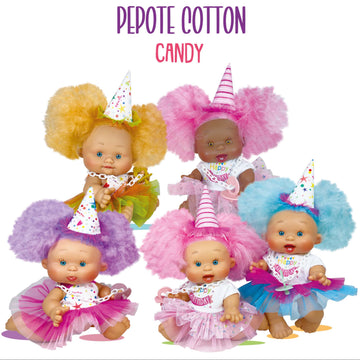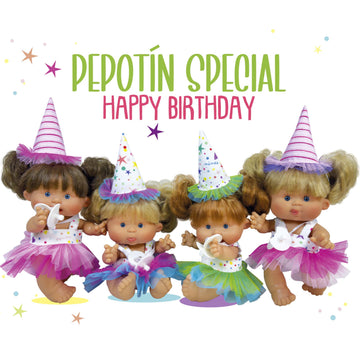Everything about Dolls And Accessories
Everything about Dolls And Accessories
Blog Article
Dolls And Accessories - An Overview
Table of ContentsThe Best Guide To Dolls And AccessoriesDolls And Accessories Can Be Fun For AnyoneDolls And Accessories for DummiesA Biased View of Dolls And AccessoriesNot known Incorrect Statements About Dolls And Accessories Not known Details About Dolls And Accessories Dolls And Accessories Fundamentals Explained
When dolls are included in group play, children practice waiting, sharing, and paying attention to others' concepts. Whether they're pretending to be a parent, brother or sister, or buddy, kids learn how partnerships workhow to sustain others, solve arguments, and take care of another person. These very early role-play experiences come to be the groundwork for healthy relationships and relationships later in life.Repeating comforting routines with a doll (feeding, shaking, closing) can aid children really feel tranquil and safe and secure. These comforting routines teach them how to self-regulate. Taking treatment of a doll can make a child really feel qualified and certain - high end dolls. It provides them a feeling of obligation and control in a world that usually feels unforeseeable.
What Does Dolls And Accessories Do?
When youngsters see dolls that reflect their race, heritage, and culture, it strengthens a favorable feeling of identity. Dolls also introduce children to societies outside their very own, building considerate interest and empathy for others.
As Dr. Karyn Purvis, a leader in kid advancement and trauma-informed care, when said: This effective quote highlights exactly how play isn't just funit's exactly how youngsters find out best. The brain wires itself via repeating. However when a kid is engaged, joyous, and psychologically connected to an activitylike doll playthe brain enhances those connections faster and a lot more meaningfully.
Not known Facts About Dolls And Accessories

Young boys require empathy, kindness, and imagination tooand doll play provides that. Dolls are commonly a kid's initial "pal," helping them exercise partnerships, develop communication abilities, and feel comforted.
See This Report on Dolls And Accessories
Via dolls that matter. Samantha Ong Samantha Ong is the founder of Joeydolls, a Canadian-based toy brand on a mission to commemorate Asian cultures via joyful, comprehensive play. Influenced by her very own experiences growing up without social depiction, Samantha designs dolls that assist youngsters really feel pleased of that they published here are while sparking curiosity and compassion in others.
Playing with dolls encourages kids to talk more about others' thoughts and emotions, a research has discovered. The research study suggests that playing imaginary games with dolls can aid kids develop social skills, concept of mind and empathy.
Little Known Facts About Dolls And Accessories.
They were additionally more probable to deal with the dolls in the 2nd person, talking to them directly, whereas the characters on the computer system display they often tended to describe in the 3rd individual. No difference was observed between children and girls."Inner state language can show that a kid is considering other individuals's ideas and emotions while playing with dolls," claimed Gerson.
And that they see language usage hereof is great confirmation of the hypothesis."Mardell included that the findings ought to apply to any kind of kind of role-play toy, as opposed to specifying to Barbies. "I would certainly take a wider view of what a doll is," he claimed." [It might be] any object that the kid can invest a sense of other right into a packed pet, an oven glove that talks to them, and even an imaginary friend."Children generally begin to show signs of inner state language around the age of 4.
The 6-Minute Rule for Dolls And Accessories
"It comes to be crucial for making and sustaining friendships, and exactly how they pick up from their instructors, and moms and dads."The research study also located that the children had raised mind task in the posterior superior temporal sulcus (pSTS) area when they spoke as though their dolls had thoughts and feelings. The pSTS area is believed to be included in the development of social and emotional handling abilities.
Childhood years is not a static life phase; without a doubt, the meaning, meaning and understanding of youth are all subject to adjustment. By the nineteenth century among one of the most extensive modifications was the relevance put on permitting youngsters to experience "the carefree pleasures" of childhood years via play tasks. Play was now considered to be a vital part of a good youth.
In order to totally comprehend the definition of play, one have to also recognize the relevance of the doll. However, dolls are much more than playthings developed to delight girls. During the nineteenth century appropriate playtime tasks were selected to promote intellectual, physical or emotional development. Dolls were especially prominent because they were assumed to foster and nurture feminine qualities such as compassion, caring and compassion.
Indicators on Dolls And Accessories You Should Know

It is just via historical examinations that researchers can wish to uncover and document the complete series of playtime experiences. Narrating these experiences, and specifically the duty of dolls, is essential for presenting a much more total photo of youth during the 19th century. Alarcn, Sara E - dolls., "Youngster's Play: The Role of Dolls in 19th Century Childhood Years" (2007 )
Report this page